Introduction
Vincent van Gogh, the Dutch Post-Impressionist painter, is renowned for his vibrant, emotionally charged artwork. His iconic paintings like “The Starry Night,” “Irises,” and “Sunflowers”, continue to captivate art lovers worldwide. But beyond his artistic genius, Van Gogh’s life story is filled with astonishing complexities. Let’s delve into some lesser-known fascinating facts about this legendary artist.
15 Astonishing Van Gogh Facts
- He only sold one painting during his lifetime.
- He painted almost 900 paintings in just ten years.
- He had many jobs before becoming an artist.
- He was close friends with Paul Gauguin.
- He once lived in England.
- He suffered from mental illness.
- He cut off part of his own ear.
- He died by suicide at the age of 37.
- His brother’s wife played a crucial role in his posthumous fame.
- His Japanese art collection influenced his work.
- Yellow was his favorite color.
- He used thick brushstrokes called “impasto.”
- The exact nature of his illness remains a debate.
- “The Starry Night” was painted from an asylum window
- His paintings are some of the most expensive ever sold.
Fact 1. He only sold one painting during his lifetime.
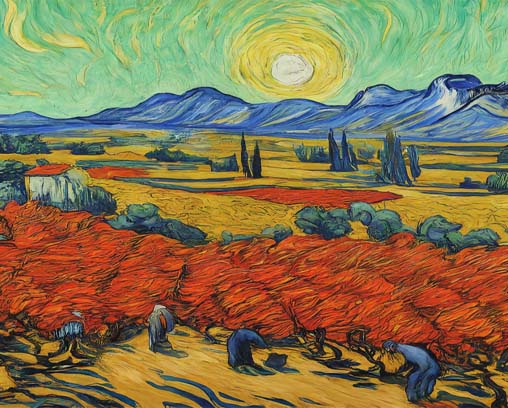
Despite his incredible talent and the vast body of work he produced, Van Gogh experienced very little commercial success while alive. Only one of his paintings, “The Red Vineyard,” was sold during his lifetime. This lack of recognition likely contributed to his financial struggles and feelings of discouragement. Ironically, his paintings now command some of the highest prices in the art world.
Fact 2. He painted almost 900 paintings in just ten years.
After discovering his passion for art in his late twenties, Van Gogh immersed himself in painting with extraordinary dedication. In the span of a single decade, he created an astonishing number of paintings – approximately 900 in total. This remarkable output demonstrates his incredible drive and the rapid evolution of his artistic style.
Fact 3. He had many jobs before becoming an artist.
Before focusing on painting, Van Gogh explored various career paths. His previous work experiences included being an art dealer, teacher, bookseller, and lay minister. These diverse life experiences likely shaped his unique perspective and ultimately informed his artistic expression.
Fact 4. He was close friends with Paul Gauguin.
Van Gogh formed a complex and often tumultuous friendship with fellow Post-Impressionist painter Paul Gauguin. They shared an intense passion for art, lived together for a time in the south of France, and influenced each other’s work. Yet, their artistic disagreements and clashing personalities ultimately led to a dramatic breakdown of their relationship.
Fact 5. He once lived in England.
As a young man, Van Gogh spent time living in London and Ramsgate, England. This period had a significant impact on him, as he developed a deep appreciation for English culture, art, and literature. His experiences there would continue to influence his thoughts and artistic sensibilities.
Read More: 15 Surprising Renaissance Facts
Fact 6. He suffered from mental illness.
Van Gogh grappled with mental health challenges throughout his life. Though the exact diagnosis is still debated, he may have experienced bipolar disorder, depression, hallucinations, or a combination of conditions. His mental struggles deeply impacted his life, relationships, and artistic expression, adding a layer of intensity and emotional depth to his work.
Fact 7. He cut off part of his own ear.
One of the most infamous incidents in Van Gogh’s life occurred in December of 1888, during a period of mental crisis. In a moment of extreme distress, likely related to a breakdown in his relationship with Paul Gauguin, he severed a portion of his left ear. The exact reasons and circumstances surrounding this event remain somewhat mysterious. It became a symbol of his troubled mental state and continues to be a subject of fascination and speculation.
Fact 8. He died by suicide at the age of 37.
After a long struggle with mental illness and personal setbacks, Van Gogh tragically died by suicide in 1890 at just 37 years old. His death cut short a brilliant and unique artistic career. However, the posthumous recognition and appreciation of his work solidify his legacy as one of the most significant figures in Western art history.
Fact 9. His brother’s wife played a crucial role in his posthumous fame.
Johanna van Gogh-Bonger, the wife of Vincent’s beloved brother Theo, played a pivotal role in bringing his artwork to the world’s attention. After both Vincent and Theo’s deaths, she tirelessly dedicated herself to collecting, preserving, exhibiting, and publishing Van Gogh’s paintings and letters. Her efforts helped to establish Van Gogh’s reputation as a visionary artist and contributed significantly to his enduring fame.
Fact 10. His Japanese art collection influenced his work.
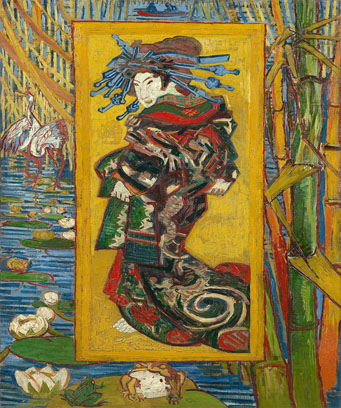
The author died in 1890, so this work is in the public domain in its country of origin and other countries and areas where the copyright term is the author’s life plus 100 years or fewer.
Van Gogh was a passionate admirer of Japanese woodblock prints (ukiyo-e). The bold colors, flat planes, graphic outlines, and unusual compositions found in Japanese art significantly influenced his development. He collected these prints avidly and even experimented with incorporating their stylistic elements into his own paintings.
Fact 11. Yellow was his favorite color.
The color yellow held deep significance for Van Gogh. He associated it with warmth, vitality, happiness, and the radiant power of the sun. Yellow features prominently and symbolically in many of his most famous works, including the “Sunflower” series and landscapes featuring golden wheat fields.
Fact 12. He used thick brushstrokes called “impasto.”
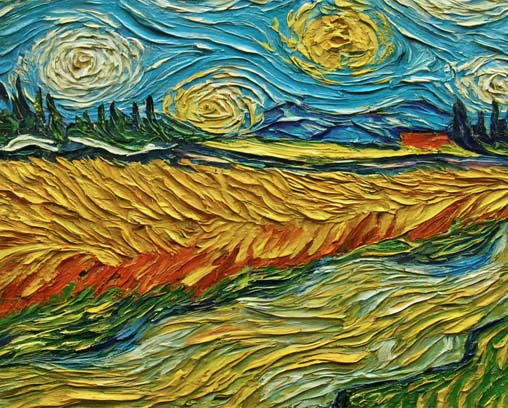
Van Gogh was known for his distinctive “impasto” technique. Impasto involves applying thick layers of paint directly onto the canvas, creating a textured three-dimensional surface. The impasto in his work adds a sense of energy and movement. His thick, swirling brushstrokes and the palpable texture of his paintings contribute to their emotional intensity and expressive power.
Fact 13. The exact nature of his illness remains a debate.
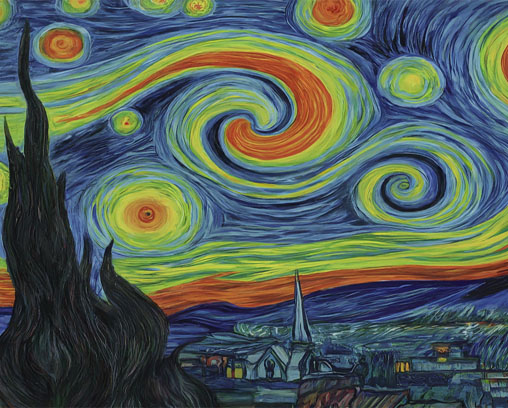
Despite countless biographies and studies of Van Gogh’s life, there’s no clear medical consensus on the exact nature of his mental illness. Over the years, experts have theorized various diagnoses, including bipolar disorder, depression, schizophrenia, temporal lobe epilepsy, and even the effects of certain medications or absinthe consumption. The complexity of his symptoms and the limitations of 19th-century medicine make it challenging to pinpoint a definitive diagnosis. The mystery surrounding his mental struggles only adds to the enduring intrigue of his story.
Fact 14. “The Starry Night” was painted from an asylum window.
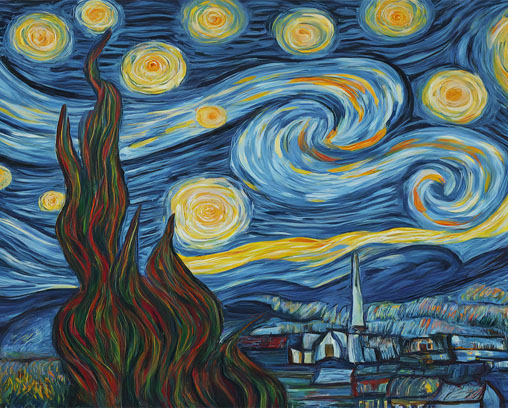
In 1889, Van Gogh voluntarily sought treatment at the Saint-Paul-de-Mausole asylum in Saint-Rémy-de-Provence. One of his most celebrated masterpieces, “The Starry Night,” depicts the view from his asylum window just before sunrise. This iconic work, with its swirling sky, vibrant stars, and idyllic village, transforms a moment of confinement into a breathtaking vision of celestial beauty. However, some scholars debate whether the swirling sky is purely an expression of his inner turmoil or if it was informed by astronomical observations.
Fact 15. His paintings are some of the most expensive ever sold.
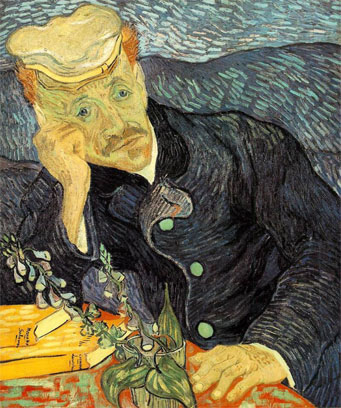
While Van Gogh faced poverty and underappreciation during his lifetime, today his artworks are considered priceless treasures. His paintings regularly fetch astronomical prices at auction. In 1990, his “Portrait of Dr. Gachet” broke records at the time, selling for over $80 million. The enduring popularity and cultural value of his work make his paintings some of the most sought-after and expensive in the art world.
Conclusion
Vincent van Gogh’s vibrant artworks and complex life story continue to fascinate and inspire. Though he faced adversity and underappreciation during his lifetime, his legacy as an artistic pioneer is undeniable. His unique vision and emotional honesty continue to resonate with viewers around the world.
15 frequently asked questions about Van Gogh
-
Where was Van Gogh born?
Van Gogh was born in Zundert, a small village in the Netherlands, in 1853.
-
What style of art is Van Gogh known for?
Van Gogh is primarily associated with the Post-Impressionist art movement. Post-Impressionists extended the use of vivid color and expressive brushwork pioneered by the Impressionists, while also emphasizing personal and symbolic meaning.
-
How old was Van Gogh when he started painting?
Van Gogh didn’t begin painting seriously until he was around 27 years old, which is relatively late compared to many other famous artists.
-
What inspired Van Gogh’s art?
Van Gogh drew inspiration from a multitude of sources. These included the natural world, his own emotional experiences, the vibrant colors and compositions of Japanese art, fellow artists, and spiritual themes.
-
What is the most famous Van Gogh painting?
His most iconic and widely recognized work is likely “The Starry Night,” a mesmerizing depiction of the swirling night sky above a small village.
-
Where are Van Gogh’s original paintings displayed?
The world’s largest collection of Van Gogh’s work is housed in the Van Gogh Museum in Amsterdam. Additionally, many of his renowned paintings can be found in major museums around the world, including the Metropolitan Museum of Art in New York, the Musée d’Orsay in Paris, and the National Gallery in London.
-
Did Van Gogh have any siblings?
Yes, Van Gogh had a close relationship with his younger brother, Theo. Theo was a constant source of emotional and financial support throughout Vincent’s life, and the two maintained a prolific correspondence through letters.
-
How did Van Gogh learn to paint?
Van Gogh was primarily self-taught. He was a dedicated observer of the world around him and carefully studied the techniques of other artists. While he did take some formal art lessons, his artistic development was mainly driven by his own experimentation and tireless practice.
-
Why are Van Gogh’s paintings so colorful?
Van Gogh’s bold use of color was a key element of his artistic expression. He used colors symbolically and emotionally, often employing vivid hues to convey feelings of joy, hope, melancholy, or intensity.
-
Did Van Gogh ever get married?
Van Gogh never married. He had a few romantic relationships throughout his life, but they were often fraught with difficulties and heartbreak.
-
What was the inspiration for “Sunflowers”?
Van Gogh’s iconic “Sunflower” series holds multiple layers of meaning. He saw sunflowers as symbols of warmth, vitality, and friendship. He also found their colors, textures, and varied stages of growth to be artistically compelling subjects.
-
Was Van Gogh influenced by other artists?
Absolutely! Van Gogh admired and studied the works of many artists. He was inspired by Japanese woodblock prints, the Dutch masters like Rembrandt, and contemporaries including the Impressionists and Paul Gauguin.
-
Are Van Gogh’s letters published?
Yes, Van Gogh’s extensive correspondence with his brother Theo was preserved and has been published. These letters provide invaluable insights into Van Gogh’s creative processes, his thoughts on art, philosophy, and his personal struggles.
-
Did Van Gogh use photography in his art?
There’s some evidence suggesting that Van Gogh may have experimented with incorporating photography into his work process. In the later years of his life, photography was becoming more accessible, and some historians believe he might have used photographs as reference for certain compositions.
-
Why is Van Gogh considered so important to art history?
Van Gogh’s influence on art history is immense. His groundbreaking use of vivid color, expressive brushwork, and deeply personal subject matter helped pave the way for modern art movements like Expressionism and Fauvism. His dedication to art in the face of personal adversity continues to inspire artists and art lovers around the globe.




